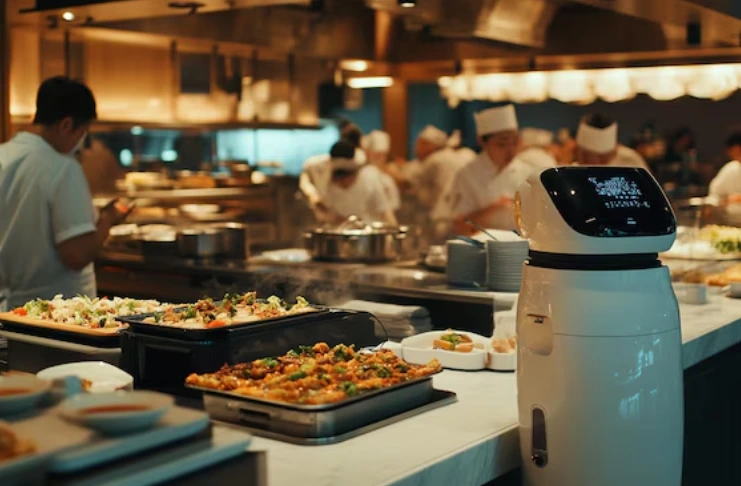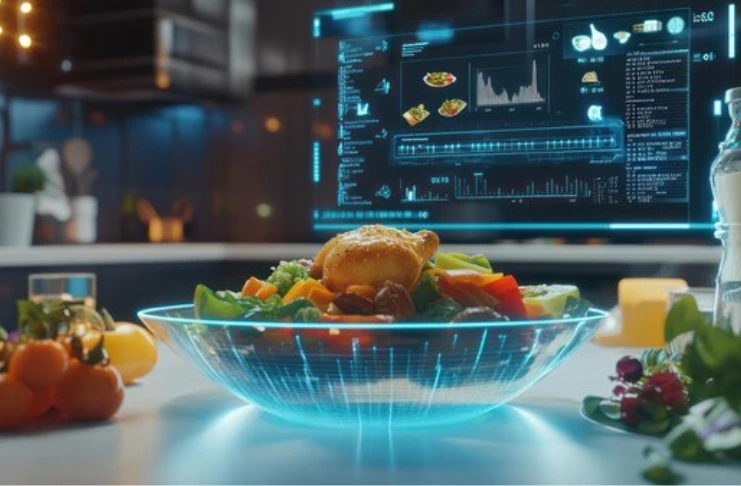
The restaurant industry is evolving rapidly, driven by technological advances that streamline operations, reduce waste, and enhance the customer experience. The global food service market is projected to grow to over $5.1 billion by 2029, and as competition heats up, restaurants need to find innovative ways to stand out and operate efficiently.
AI (Artificial Intelligence) and Automation are revolutionizing restaurant operations, enhancing both customer interactions and back-of-house efficiencies. Whether running a fine-dining establishment, a fast-food chain, or a small café, AI tools can address critical operational challenges, reduce costs, and increase profitability.
This blog will explore ways to use AI and automation to revolutionize restaurant operations.
1. Automating Front-of-House Services
Front-of-house (FOH) plays a crucial role in shaping customer satisfaction. Addressing long wait times, incorrect orders, and impersonal service is essential to retaining customers. AI offers various solutions to enhance customer-facing services significantly, such as AI-powered phone Systems and Voice Assistants.
AI-powered phone systems are revolutionizing how restaurants handle table reservations, customer inquiries, and orders. These systems can handle calls, answer questions, and place orders without human intervention, which is particularly valuable during peak hours when staff are busy serving in-house guests.
With AI phone systems, you can:
- Automate reservations: AI can book tables, manage waiting lists, and confirm reservations via phone or chat.
- Take orders: Customers can place orders via phone or voice-activated systems, which automatically integrates into the restaurant’s POS system.
- Answer FAQs: AI systems can address common customer queries, such as hours of operation, menu availability, or promotions.
Example: Poppy’s Pizza & Grill saw increased productivity when AI systems answered up to 40 daily calls, allowing staff to focus on service quality. Additionally, online sales surged by 132%.
Voice-activated ordering in Drive-Thrus
Voice technology is gaining popularity, with 53% of people using it to search for restaurants and menus. By incorporating voice-activated systems in drive-thrus or self-service kiosks, businesses can expedite ordering and minimize errors.
Fast-food giants like McDonald’s and Taco Bell have embraced voice AI technology to optimize drive-thru operations. This technology guarantees more precise orders, reduced wait times, and an improved customer experience. To implement voice technology:
- Set up self-service kiosks with AI-driven voice assistants to take orders.
- Use drive-thru voice ordering systems that can understand customer preferences and predict popular items.
- Implement multi-language support for voice assistants, making the ordering process smoother for a diverse clientele.
Self-Service Kiosks
AI-powered kiosks allow customers to independently place and customize their orders, enhancing the overall experience. Fast-food restaurants like KFC are increasingly adopting this technology, allowing for more personalized and efficient service. Some establishments even integrate facial recognition to identify regular customers and provide tailored recommendations based on their ordering history.
2. Optimizing Back-of-House Efficiency with AI
While AI revolutionizes customer interactions, it’s equally transformative behind the scenes. Back-of-house (BOH) operations are ripe for optimization with AI solutions that can minimize waste, improve stock management, and streamline food preparation processes.
AI-Driven Inventory Management
Food waste is costly for restaurants, with industry estimates suggesting that 10% of food inventory is wasted. AI-powered inventory management systems track real-time usage, predict demand patterns, and automatically suggest optimal stock levels.
With an AI-powered inventory system, you can:
- Predict demand: AI uses historical data to forecast sales trends and suggest purchasing amounts, helping avoid overstocking or under-ordering.
- Reduce waste: Automated tracking ensures that food items are used before they spoil, reducing waste and lowering food costs.
- Integrate POS systems: Connect your POS system to your inventory management tool to track what’s selling in real-time and ensure ingredients are available.
Example: Restaurants using AI-based inventory tools have reduced wastage by up to 20%, cutting costs and boosting profits.
Smart Kitchen Automation
Automating kitchen workflows can increase efficiency and consistency. With smart kitchen systems, cooking times are monitored and adjusted based on order load, and predictive maintenance tools alert staff when kitchen equipment needs servicing before it breaks down. AI can:
- Schedule tasks: Automatically assign tasks to kitchen staff based on real-time order volumes and available resources.
- Ensure consistency: AI can monitor cooking processes to ensure that dishes are prepared consistently, maintaining quality across shifts.
- Predictive maintenance: Smart sensors can track the performance of kitchen appliances and schedule maintenance before a breakdown occurs, significantly reducing downtime.
3. Enhancing Customer Experience with AI
AI’s role isn’t just to streamline operations; it’s also about delivering a better, more personalized customer experience. With data analytics and machine learning, AI can provide insights that help you cater to customer preferences and keep them coming back.
AI for Personalized Marketing
Consumers crave personalized experiences, and AI can help restaurants offer them. AI tools use machine learning to analyze customer data from past orders, preferences, and behavior to provide personalized marketing promotions.
With AI-driven marketing tools, you can:
- Target specific customers: Send personalized promotions using data from loyalty programs, online ordering, and POS systems.
- Upsell effectively: AI can predict what customers will likely order next and suggest additional items or upgrades.
- Create dynamic menus: AI can adjust digital menus in real-time based on customer data, highlighting popular items or promoting new dishes.
AI Chatbots for Online Review Management
Managing your online reputation is crucial, mainly as customers increasingly rely on reviews to make dining decisions. AI-powered chatbots can help manage and respond to reviews on platforms like Google, Yelp, and TripAdvisor. AI tools can:
- Respond to reviews: Generate personalized responses to customer reviews, ensuring that feedback is acknowledged.
- Flag negative reviews: Alert managers to negative feedback that requires immediate attention, allowing for timely resolution of issues.
58% of consumers are willing to pay more for restaurants with better reviews, so effective AI-driven review management can positively impact your bottom line.
4. AI for Smarter Resource Allocation
AI also plays a crucial role in staff management and resource allocation. Using predictive analytics, AI can help restaurants manage their workforce more efficiently and reduce overhead costs.
AI for Demand Forecasting and Scheduling
One of the challenges many restaurants face is optimizing staffing levels based on demand. Overstaffing leads to unnecessary labor costs, while understaffing can result in better service and happier customers. AI-driven tools can analyze historical sales data, local events, weather forecasts, and more to predict foot traffic and adjust staffing accordingly.
With AI-based scheduling, you can:
- Optimize labor costs: Adjust shifts based on real-time demand forecasts to ensure you have the correct number of staff at the right time.
- Prevent employee burnout: Predicting busy periods helps you schedule additional staff in advance, avoiding burnout during peak hours.
Example: Domino’s uses AI to forecast peak delivery times and adjust driver shifts accordingly, ensuring they meet demand while minimizing labor costs.
5. AI-Enabled Predictive Analytics for Menu Optimization

Predictive analytics powered by AI can analyze historical data and real-time trends to inform menu decisions. By understanding which items sell best at different times, days, or seasons, restaurants can:
- Optimize menus: Remove underperforming items and highlight best-sellers.
- Reduce waste: Predict ingredient usage more accurately, ensuring the right amount of food is stocked.
- Enhance profitability: AI can suggest menu pricing adjustments based on demand, cost of goods, and competition.
Restaurants like McDonald’s have been using AI-driven predictive analytics to customize drive-thru menus, offering items likely to sell well based on time of day and customer data.
6. Using AI for Automated Customer Feedback Collection
Understanding customer satisfaction is critical to making improvements. AI can help restaurants gather customer feedback through automated systems, such as post-dining surveys via text or email. These systems can:
- Identify patterns: AI can analyze feedback for common complaints or areas for improvement.
- Provide actionable insights: Restaurants can quickly act on AI-driven insights to improve the dining experience.
- Gauge loyalty: AI tools can also track customer sentiment and identify your most loyal customers, who will likely return and promote your restaurant.
The Future of AI in Restaurants
AI and automation are rapidly becoming integral to the restaurant industry and will only continue to grow in the future. From predictive analytics to fully automated kitchens, AI has the potential to revolutionize every aspect of restaurant operations.
While major chains like McDonald’s and Taco Bell are leading the way, independent restaurants can benefit from AI-driven tools to enhance customer service, reduce operational costs, and improve overall efficiency.
Embracing AI enables restaurants to stay ahead of the curve, offering superior dining experiences while maximizing profitability. It’s essential to view AI not as a replacement for human staff but as a tool that empowers teams to deliver better service.
Conclusion
AI and automation have the potential to transform the restaurant industry. They offer tools that help restaurant owners streamline operations, enhance customer experiences, and boost profitability. The benefits are clear, whether through AI-powered phone systems, voice assistants, self-service kiosks, or smart inventory management.
By leveraging AI technologies, restaurants can stay competitive, deliver a more personalized experience, and reduce operational inefficiencies. As AI continues to evolve, it will become even more integrated into restaurant operations, making it a must-have for forward-thinking establishments.
Now is the time to embrace AI and take your restaurant to the next level.








